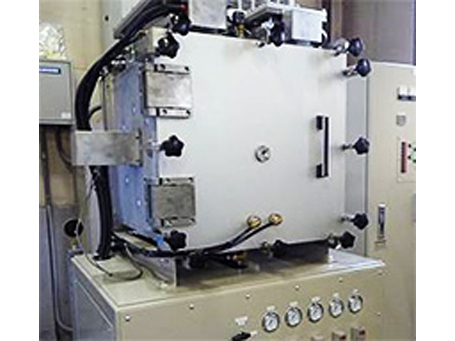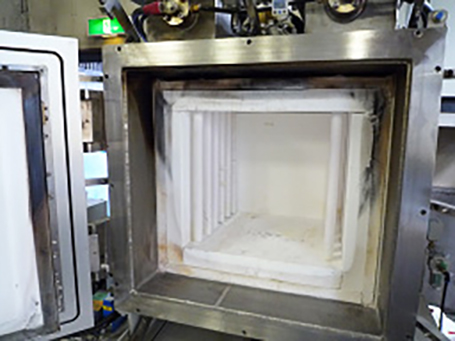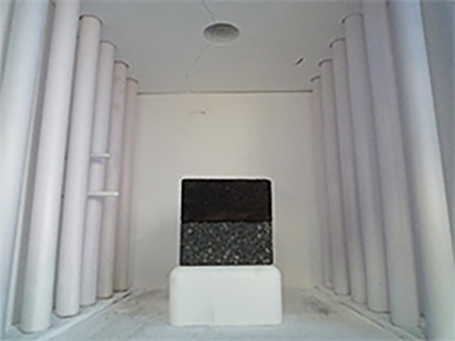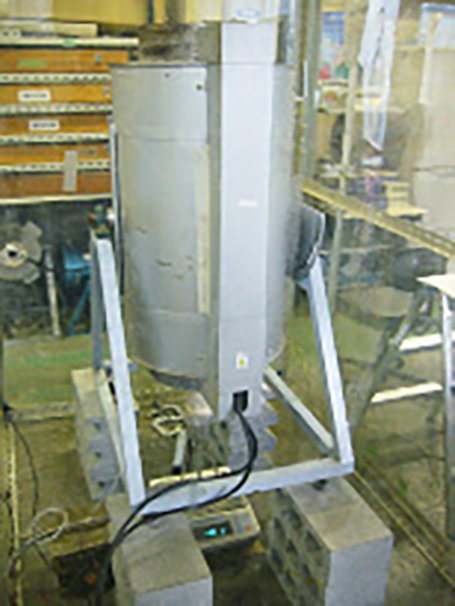Catalyst Evaluation and Development Support
High Temperature Atmosphere Reaction and Heat Treatment Test to Support Evaluation of Catalysts
In-page menu
As a distinctive feature of this furnace, testing under a diverse range of atmospheres is possible.
Main features of multi-function heat treatment furnaces
- in addition to pure gases, Heat treatment testing is also possible under various mixed gas atmospheres.(Please inquire regarding available gas species and other test conditions.)
- Heating up to 1600℃ is possible; crucible melting is also available.
- Temperature variations are extremely slight, enabling stable heat treatment.
- Observation of the condition in the furnace during treatment is also possible.
-

Appearance of multi-function heat treatment furnace -

Interior of multi-function heat treatment furnace
Overview of multi-function heat treatment furnace
-
Available atmospheres
- Air, nitrogen (N2), argon (Ar), carbon monoxide(Co), ammonia (NH3), hydrogen gas (H2), vacuum (basic specifications).
- Can also respond to a diverse range of other requirements, including inert, reducing, and oxidizing atmospheres, etc.
-
Large capacity
- Effective volume of heated part: 250 mm × 250 mm × 250 mm
(Treatment of A4 size and other large-scale specimens and parts is also possible.)
- Effective volume of heated part: 250 mm × 250 mm × 250 mm
-
High temperature
- Max. temperature: 1600℃
- High temperature treatment (melting) of ferrous, nonferrous, and other materials is possible.
- Addition/sampling during treatment is possible by using the furnace-top opening.
-
Inside observation during treatment
- Furnace has sight glasses on the top and side, enabling observation of the condition in the furnace during treatment.
Example of heat treatment test
Heat Treatment Testing of Various Materials/Parts
As a distinctive feature of this furnace, testing under a diverse range of atmospheres is possible. Taking advantage of this feature, heat treatment testing can be performed under a wide range conditions.
-
Example of test condition Atmosphere Temparature Material N2 atmosphere 800℃ metal plates H2 atmosphere 1100℃ metal parts N2 + CO2 + water vapor mixed gas 1000℃ steel Actual examples
- Steam oxidation test of steel
- Reduction test of oxide powder
- Decarburization test of steel
- Heat treatment test of metal plates, etc.
-

Heat treatment test of a part
Measurement of High Temperature Behavior
-
-
Measurement and observation of high temperature deformation, reaction, and melting behavior, etc. is possible by using the furnace observation windows.
When placed in a high temperature atmosphere, materials undergo various types of deformation, such as swelling, softening, melting, etc. The material shape also changes as a result of reaction with the atmosphere gas (e.g., oxidation, carburization, nitriding, etc.).
When placed in contact with a different material, phenomena such as bonding, reaction, sintering, etc. may also occur between the two materials. - Using JFE-TEC's facilities, it is possible to reproduce actual service conditions (atmosphere, temperature) and investigate material deformation and the progress of reaction behavior.
-
Measurement and observation of high temperature deformation, reaction, and melting behavior, etc. is possible by using the furnace observation windows.
-

Under-load reaction test of dissimilar materials
Measurement and visual observation of dimensional and weight changes are also possible.
-

Measurement of weight change
during high temperature treatment -
In addition to the heat treatment furnace described above, JFE-TEC also has a tube furnace which can be selected depending on the purpose of testing. This facility enables not only comparison of the specimen appearance, dimensions, and weight before/after high temperature treatment, but also measurement of dimensional and weight changes during the high temperature test.


